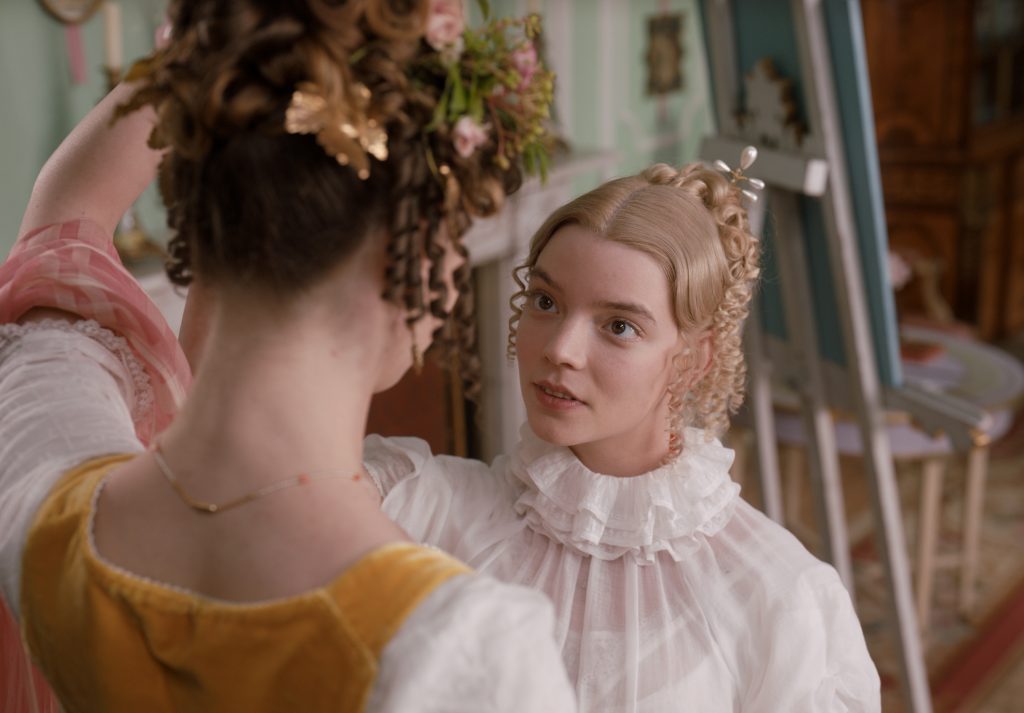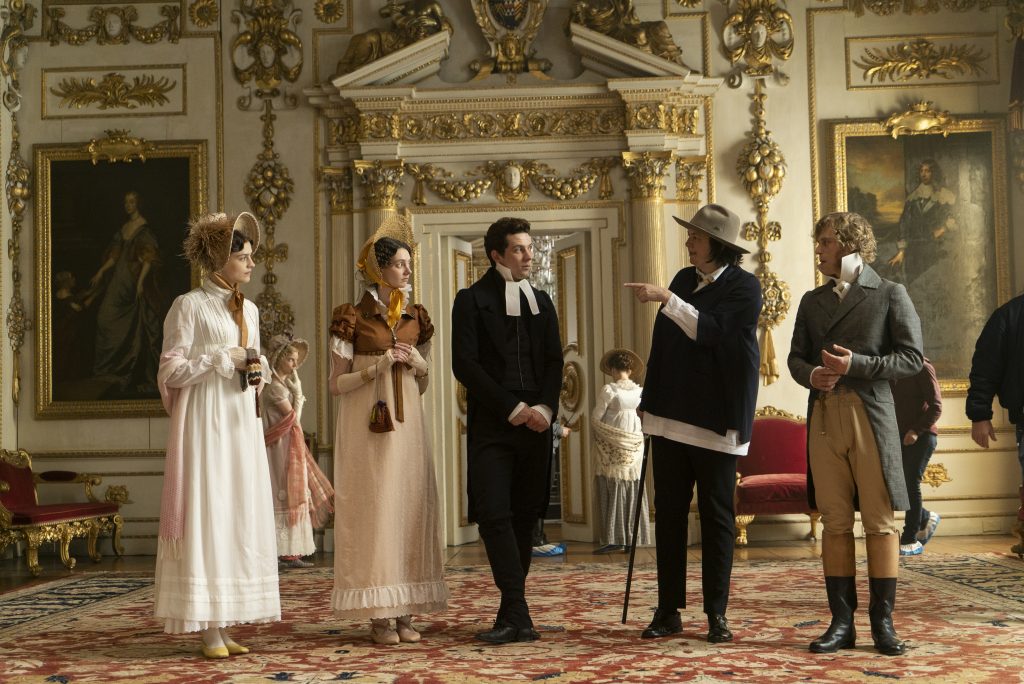Welcome to In Videos Veritas, where accuracy and artistic licence fight it out in the coliseum of audience experience. This month, I’m taking a look at Autumn de Wilde’s adaptation of Jane Austen’s Emma.
The goal of this column is not to lambast a piece of media for failing to deliver perfect “historical accuracy”, something that is impossible to define, impossible to achieve, and rarely ever an acknowledged intention of the creators anyway. Nor is it my goal to overly praise works that feel authentic to their period but fall flat in other areas. It is simply interesting to explore how fact and fun interact, with an ultimate focus on what we are willing to include, embellish, or omit from the former in order to attain the latter.
So why start with Austen? Well, as Devoney Looser observes, ‘seeing her as ahistorical means ignoring her insights into social, if not political, history’. With her enduring popularity, and the continued popularity of media set in the Regency period, gaining an understanding of the era is key to enjoying and engaging with her continued legacy.

Capturing Class
Emma., released in 2020, is that rare thing: an Austen adaptation that is satirical, sentimental, and surprisingly successful at blending the two. It is the definitive screen version of Austen’s 1815 novel, signified by the stylish little full-stop that sits at the end of its title. Although the “Jane Mania” of the 1990s is long since passed, the last couple of years have offered modern audiences more than the occasional taste of Austen, from the adaptations of Sanditon and Persuasion (even if the latter better suits the term “abomination”) to media inspired by her work like Bridgerton and Fire Island.
None of these recent takes have felt more authentically Austen than Emma. Autumn de Wilde evidently understands the comedy of manners genre and, alongside screenwriter Eleanor Catton, made a consistent effort to showcase Austen’s ironic point of view without compromising the moralistic elements of the narrative. The result is a story that still feels as if it were written in Regency England, with characters whose outlooks, actions, and affectations feel distinct from, if not entirely detached from, modern perspectives.
Partly this is achieved through the film’s presentation of class. Austen’s own attitude towards class divisions is ‘notoriously hard to pin down’, and de Wilde embraces this ambiguity. Household staff are a highly visible and near-constant presence in Emma., helping the characters to dress, serving them tea, and generally performing any task that seems a little bit too much like hard work for the poor aristocrats. The cuts to the household staff as they share subtle, committedly blank looks during particularly ridiculous moments invite us to laugh more freely at the absurdity of polite society. It took at least 50 indoor servants to run a house approximately the size of Hartfield, and de Wilde does not choose to ignore this—as many other adaptations do.

As Carol M. Dole observed, the ‘chief target’ of Emma is snobbery, something which this adaptation captures wholeheartedly. Anya Taylor-Joy presents us with a clever, cool, superiorly bitchy Emma Woodhouse, whose treatment of those she sees as inferior is at best patronising and at worst outrightly hostile. Her entitlement is often encouraged by those around her, especially her indulgent father, doting governess, and awestruck friend-come-project-come-plaything, Harriet. The truth of the matter is that Emma Woodhouse occupies a distinctly enviable and rare position in the Regency Era, that of a young woman who does not need to marry for security. She doesn’t want “fortune, employment, or consequence”, and feels herself to be far more a mistress of her father’s house than she would be of her husband’s. Her privilege is emphasised by the other characters around her; whilst they struggle for legitimacy, security, and meaningful occupation, she simply seeks amusement.
The ending of Emma is perhaps Austen’s most true to life, in that every character ends up married within their ;station’, Emma marries Mr Knightley, her equal in social standing who’s family is already tied to hers; the illegitimate Harriet is paired off with a prosperous farmer; and Frank Churchill, an overindulged heir to a large fortune, makes a secret marriage to a woman with the right family name.
The film stresses that Frank has behaved badly, but also that he will face no consequences, and that in fact everyone will rush to forgive him to reap the benefits of his patronage. It is not a complete reach to compare Frank Churchill to George IV, who was Prince Regent at the time the novel was published. George IV’s rakish behaviour attracted criticism, and there is a hint of his excessive vanity in Frank Churchill taking a day trip to London just to get a haircut. Jane Austen allegedly did not like the Prince Regent due to his treatment of his wife, and was presumably therefore far from thrilled when he revealed himself to be an avid fan of her works. Despite this supposed dislike, Austen dedicated Emma to him. Perhaps she agreed to include this dedication in the hopes that the Prince would find something of himself in the character of Frank.

Details of Dress
Another authentic element of the film is its costumes. Designer Alexandra Byrne took inspiration from Regency fashion plates and extant garments (like this one), and some of the items that appear are direct imitations of contemporary pieces. We see characters being dressed and undressed multiple times within the film, showcasing the elaborate layering that went into creating the iconic silhouettes. The colours, textures and fabrics used display a deep understanding of contemporary clothing, and even the more outlandish fashions haven’t been altered to appeal to modern audiences.
Of course, there are a few discrepancies. The men’s costumes are not quite as pitch-perfect in silhouette, there are a couple of instances where characters wear daywear in evening scenes, and some of the hairstyles are overtly anachronistic, but the overall effect is top notch. Regency clothing has never been done better, and who doesn’t want to wear Emma’s iconic sunshine yellow pelisse? Emma. is proof that you don’t need glittery appliqué and beach waves to make period fashion seriously desirable.
When investigating the authenticity of Emma., there are numerous other elements that could be discussed; the use of folk music and live performance; the use of settings and gendered spaces; the presentation of manners, and marriage, and masculinity to name just a few.
All that is left is to commend the creative team and cast for their commitment to capturing the ‘difficult beast’ that is Emma; praise the confession scene for being the most eccentric, outlandishly brilliant thing in the entire Austen-adaptation pantheon (trust me); and to state that, by comparison, the 1996 adaptation featuring Gwyneth Paltrow is a saccharine, over-sentimentalised snoozefest.
In Video Veritas rating
Fact: 7/10
Fun: 9/10
Overall: 8/10
Words by Briony Havergill
Support The Indiependent
We’re trying to raise £200 a month to help cover our operational costs. This includes our ‘Writer of the Month’ awards, where we recognise the amazing work produced by our contributor team. If you’ve enjoyed reading our site, we’d really appreciate it if you could donate to The Indiependent. Whether you can give £1 or £10, you’d be making a huge difference to our small team.
